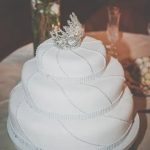Looking to add an elegant touch to your cake designs? Learn how to use silicone lace molds for cake decorating and elevate your creations to the next level. Whether you are a professional baker or a hobbyist, silicone lace molds offer endless possibilities for creating intricate and delicate designs that will impress any audience.
Silicone lace molds have become increasingly popular in the world of cake decorating due to their versatility and ease of use. These flexible and detailed molds allow you to create stunning lace patterns that can be applied to fondant, buttercream, or even chocolate. In this article, we will explore the various techniques and tips for using silicone lace molds to enhance your cake decorating skills.
From choosing the right mold for your design to cleaning and storing it properly, we will cover everything you need to know about working with silicone lace molds. Whether you are new to using these molds or looking for creative ways to incorporate them into your cake designs, this comprehensive guide will help you master the art of using silicone lace molds for cake decorating.
Choosing the Right Silicone Lace Mold for Your Cake Design
Silicone lace molds come in a variety of designs, shapes, and sizes, making it important to choose the right one for your specific cake design. When selecting a silicone lace mold for cake decorating, consider the theme or style of the cake, as well as the size and shape of the cake tiers.
For example, if you are creating a vintage-inspired wedding cake, you may want to choose a lace mold with intricate floral patterns. On the other hand, if you are decorating a simple birthday cake, a more geometric lace design might be more suitable.
Another factor to consider when choosing a silicone lace mold is the flexibility and durability of the material. Look for molds made from high-quality food-grade silicone that is flexible enough to release the lace without breaking it. It’s also important to ensure that the mold is easy to clean and can withstand repeated use.
Additionally, consider the size of the silicone lace mold in relation to the size of your cake tiers. If you are decorating a multi-tiered cake, you may need multiple molds in different sizes to fit each tier properly. Some molds are designed specifically for smaller or larger cakes, so be sure to select one that aligns with your overall cake design.
Here’s a helpful tip: Before making your final decision, look at customer reviews and ratings for different silicone lace molds to get an idea of their quality and ease of use. By doing some research beforehand, you can ensure that you choose a silicone lace mold that will help bring your cake decorating vision to life.
| Choosing the Right Silicone Lace Mold | Considerations |
|---|---|
| Design | Match theme/style of cake |
| Material | High-quality food-grade silicone |
| Size | Fits cake tiers properly |
Preparing Your Silicone Lace Mold for Use
Before you can start using your silicone lace mold for cake decorating, it is important to properly prepare the mold for use. This step is crucial in ensuring that your lace design comes out perfectly and that the mold remains in good condition for future use.
The first thing you’ll want to do is clean your silicone lace mold with warm, soapy water. This will help remove any residue or dust that may have accumulated on the surface of the mold.
Once your silicone lace mold is clean, it’s a good idea to lightly grease the inside of the mold with a non-stick cooking spray or a small amount of vegetable oil. This will help prevent the fondant or gum paste from sticking to the mold, making it easier to remove the lace design once it has set.
Be sure to evenly coat the entire inside surface of the mold, paying special attention to any intricate details within the design.
After greasing your silicone lace mold, you’ll want to gently tap it on a flat surface to release any air bubbles that may have formed during greasing. This will help ensure that your lace design comes out smooth and free of imperfections.
Once this preparation process is complete, your silicone lace mold is ready to be used for creating beautiful and intricate designs for your cakes. Following these steps will ensure that you get the best results when using silicone lace molds for cake decorating.
Techniques for Using Silicone Lace Molds on Fondant
Fondant is a popular choice for cake decorating due to its smooth, flawless finish. Using silicone lace molds on fondant can add intricate and delicate designs to your cake that will impress any guest. In this section, we will discuss the techniques for using silicone lace molds on fondant and provide tips for achieving the best results.
Rolling Out the Fondant
Before using a silicone lace mold on fondant, it is essential to roll out the fondant to the desired thickness. It should be thin enough to capture the details of the lace mold but not too thin that it becomes fragile and difficult to work with. A thickness of about 1/8 inch is ideal for most lace mold designs.
Pressing the Mold Into the Fondant
Once you have rolled out the fondant, lightly dust the surface of the silicone lace mold with cornstarch or powdered sugar to prevent sticking. Gently press the mold onto the fondant, applying even pressure to ensure that all details are captured. Carefully lift off the mold to reveal your beautiful lace design on the fondant.
Trimming and Applying
After you have pressed the silicone lace mold onto the fondant, carefully trim around the edges of the design using a sharp knife or a small pair of scissors. Once trimmed, you can apply the lace design to your cake by gently pressing it onto your frosted cake surface. The result will be a stunning cake adorned with elegant lace designs created using silicone molds.
By following these techniques, you can easily elevate your cake decorating skills and create intricate and beautiful designs using silicone lace molds on fondant. With practice and creativity, you can use different types of lace molds to add unique touches to your cakes for any occasion.
Tips for Using Silicone Lace Molds on Buttercream
Buttercream is a popular choice for cake decorating due to its smooth and creamy texture. Using silicone lace molds on buttercream can add an elegant and intricate touch to your cake designs. However, it requires some special techniques to ensure that the lace design comes out perfectly. Here are some tips for using silicone lace molds on buttercream:
Chill Your Buttercream
Before applying the silicone lace mold to your buttercream, it is crucial to chill the buttercream first. This will help the buttercream firm up, making it easier to press the silicone lace mold onto the surface without damaging the buttercream’s texture.
Use a Thin Layer of Buttercream
When using silicone lace molds on buttercream, it’s best to apply a thin layer of buttercream onto the cake surface. A thin layer ensures that the details of the lace mold will show through clearly without getting lost in a thick layer of buttercream.
Press Gently and Evenly
Once you have chilled your buttercream and chosen the right silicone lace mold for your design, gently press the mold onto the buttercream surface. Apply even pressure across the entire mold to ensure that all details are transferred onto the buttercream.
By following these tips, you can effectively use silicone lace molds on buttercream to enhance your cake decorating skills and create stunning designs that will impress everyone at your event.
Removing the Lace From the Mold and Applying It to Your Cake
After preparing your silicone lace mold, the next step in using it for cake decorating is removing the lace from the mold and applying it to your cake. This process requires careful handling to ensure that the lace comes out perfectly and is placed on the cake effectively. Follow these steps to achieve a flawless result with your silicone lace mold:
1. Gently flex the mold: Once your fondant or buttercream has set, carefully flex the silicone lace mold to release the lace. Start from one edge and work your way around, being cautious not to tear or damage the delicate lace design.
2. Use a soft brush: To help release any stubborn areas of the lace from the mold, lightly brush the back of the mold with a soft, dry pastry brush. This will help loosen any areas that may be sticking to the mold without causing any damage to the lace.
3. Apply on cake: Once you have successfully removed the lace from the mold, carefully place it onto your cake using gentle pressure to adhere it to the surface. You can use a small offset spatula or a pair of tweezers for precision placement.
By following these simple steps, you can effectively remove intricate lace designs from silicone molds and apply them flawlessly to decorate your cakes for any occasion.
Tips:
– Work slowly and patiently when removing the lace from the silicone mold to avoid tearing.
– If working with larger pieces of lace, consider enlisting someone’s help to ensure that it is applied smoothly onto your cake without stretching or distorting its shape or design.
– Practice removing smaller sections of lace first before attempting larger pieces in order to gain confidence and improve your technique.
Cleaning and Storing Your Silicone Lace Mold
After using silicone lace molds for cake decorating, it is important to properly clean and store them to ensure their longevity and continued effectiveness. Cleaning the mold is simple and straightforward. Start by gently washing the mold with warm soapy water, taking care to remove any leftover fondant or buttercream residue. Use a soft-bristled brush or sponge to gently scrub the mold, making sure to reach all the intricate details of the lace pattern.
Once you have thoroughly cleaned the silicone lace mold, allow it to air dry completely before storing it. It is essential to store your silicone lace molds properly to prevent any damage or deformation. The best way to store these molds is in a cool, dry place away from direct sunlight and heat sources. Avoid folding or bending the molds, as this can cause them to lose their shape and detail.
By following these simple cleaning and storage steps, you can ensure that your silicone lace molds remain in good condition for future use. Whether you are an experienced cake decorator or just starting out, knowing how to use silicone lace molds for cake decorating can open up a world of creative possibilities for your confectionery creations.
Creative Ways to Use Silicone Lace Molds for Cake Decorating
Silicone lace molds are a versatile and fun tool to use for cake decorating. While they are typically used to create intricate lace designs for cakes, there are many creative ways to use silicone lace molds to elevate your cake decorating skills.
One creative way to use silicone lace molds is to create edible lace decorations for cupcakes or cookies. Simply press the silicone mold onto rolled fondant or gum paste, cut out the design, and place it on top of your cupcakes or cookies for an elegant and unique touch. Edible lace decorations can add a delicate and sophisticated look to any dessert.
Another creative idea is to use silicone lace molds to make chocolate or sugar decorations for cakes. Melted chocolate or sugar can be poured into the mold, allowed to set, and then carefully removed and applied to the cake. This adds a three-dimensional element to your cake design and can be a stunning focal point.
Additionally, you can also use silicone lace molds as stencils for airbrushing designs onto cakes. Place the mold onto the surface of the cake and spray over it with food coloring, creating a beautiful intricate pattern. This technique allows for endless customization and creativity when decorating cakes.
Overall, thinking outside the box when using silicone lace molds can lead to some truly stunning and unique cake designs. Whether it’s creating edible lace decorations, making chocolate or sugar decorations, or using them as stencils for airbrushing, there are countless ways to get creative with silicone lace molds for cake decorating.
Conclusion
When it comes to cake decorating, silicone lace molds can be a game-changer for adding intricate and delicate details to your designs. By following the tips and techniques outlined in this article, you can enhance your cake decorating skills and take your creations to the next level.
With the right silicone lace mold, proper preparations, and some creativity, you can create stunning designs on both fondant and buttercream cakes. The versatility of silicone lace molds allows you to explore various patterns and styles, giving you endless possibilities for customizing your cakes.
Whether you’re a professional baker or someone who simply enjoys baking as a hobby, learning how to use silicone lace molds for cake decorating can open up new avenues for expressing your creativity. Experiment with different techniques, colors, and applications to discover the full potential of these versatile tools. With practice and patience, you’ll be amazed at the beautiful lace designs you can achieve on your cakes.
In conclusion, incorporating silicone lace molds into your cake decorating repertoire can truly elevate your skills and bring a touch of elegance to your creations. As you continue to explore and experiment with these molds, remember that the key to mastering them lies in practice and experience. So go ahead, unleash your creativity, and let silicone lace molds take your cake decorating to new heights.
Frequently Asked Questions
How Do You Keep a Cake From Sticking to Silicone Mould?
To prevent a cake from sticking to a silicone mold, it’s important to properly grease the mold with either butter or non-stick cooking spray before pouring the batter in. Additionally, allowing the cake to cool completely before attempting to remove it from the mold can also help prevent sticking.
What Icing Do You Use in Silicone Molds?
When using silicone molds for icing, it’s best to use royal icing or fondant as they are both firm enough to hold their shape when removed from the mold. These types of icings work well in silicone molds and can easily be transferred onto cakes or other baked goods.
Can You Use Cake Mix in Silicone Molds?
Cake mix can definitely be used in silicone molds. Simply prepare the cake mix according to its instructions and then pour it into the greased silicone mold. It’s important to ensure that the mold is filled appropriately and evenly to achieve consistent results. After baking, allow the cake to cool before removing it from the mold for best results.

Welcome to my blog about home and family. This blog is a place where I will share my thoughts, ideas, and experiences related to these important topics. I am a stay-at-home mom with two young children. I hope you enjoy reading it! and may find some helpful tips and ideas that will make your home and family life even better!





